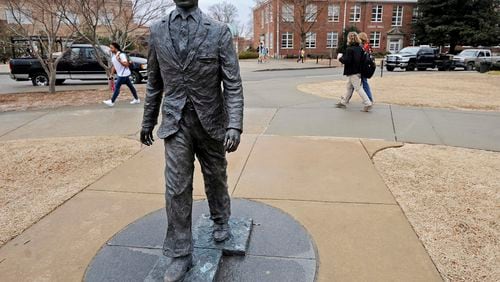It’s been a tough week to be an Ole Miss Rebel.
Last Sunday, a statue of James Meredith, the first African-American student to attend the University of Mississippi, was discovered with a noose around its neck and an old-style Georgia state flag — that includes the Confederate banner — draped across it.
Memories of Mississippi’s hard history of racism and violence could not have found a more direct route back into the national consciousness. University officials and law enforcement — including the FBI — are investigating the incident and three freshmen from Georgia have been identified as suspects.
The students, who have not been identified, are members of the Sigma Phi Epsilon fraternity at Ole Miss. The fraternity’s national headquarters responded Friday by kicking the students out and then suspending the campus chapter.
For longtime observers like Rick Cleveland, who heads the Mississippi Sports Hall of Fame and Museum, the incident at the Meredith statue was a gut punch.
“They have worked so hard at Ole Miss,” he said.
Cleveland spent decades as a sportswriter in the state and watched the university wrestle for years with its troubled Rebel image. He hosted Ole Miss Chancellor Dan Jones at a luncheon Monday as news of the incident spread.
“You could just look at him and see that it had worn on him,” he said.
Jones and his predecessor, Robert Khayat, took controversial steps in the past 15 years to downplay the university’s Old South image in favor of a more culturally sensitive approach.
Khayat banned the Confederate flag from football games and in 2003 gave the boot to mascot Colonel Reb – a white-bearded caricature of a Southern plantation owner. The moves earned praise from some corners and hate mail from others.
In 2009, Jones ordered the marching band to stop playing “From Dixie With Love” at athletic events when fans ignored requests not to shout “The South will rise again” at the end of the song. In 2010, the student body voted a black bear as its mascot, putting even more distance between the university and its Old South image.
The university is often undercut by students and fans insulted by the changes. The Colonel Reb Foundation – founded in 2003 – sells T-shirts and other merchandise featuring the mascot under the slogan “Tradition Matters at Ole Miss.”
Events like the desecration of Meredith’s statue feed a longstanding narrative about the university and the state that overwhelm years of gradual change.
“Very few people know about the William Winter Institute,” Cleveland said. The institute, housed on the Ole Miss campus, works for racial reconciliation in Mississippi and elsewhere.
Others, like NAACP State President Derrick Johnson, said while Ole Miss has made progress, there is more the school should do to send a consistent message to its students.
“The main avenue on campus is Confederate Drive,” he said. “And they still have many monuments honoring the Confederacy and Old South.”
Ole Miss should “purge” itself of such relics, he said. “To do that will be the true testament on how they have tried to reverse course on race in Mississippi.”
Hope Owens-Wilson, a 21-year-old African American studies student at Ole Miss, said her university is not a sanctuary for bigots, but it has not unpacked all its racial baggage either.
“I think it’s somewhere in the middle,” she said. “I think we’re in this period of backlash where people who are unwilling to relinquish any sort of power to change are upset.”
Last week, Owens-Wilson organized a campus forum for students, faculty and supporters from Oxford to discuss their feelings about the vandalism. She asked those who attended to write down their reactions in one or two words.
“Some ranged from no surprise and some people were really hurt by the incident,” she said.
Jonece Dunigan, a 21-year-old journalism student, said this is just the latest in a series of incidents at the school.
Last fall, an on-campus performance of a “The Laramie Project” — a play about the 1998 murder of University of Wyoming student Matthew Shepherd, who was gay — was interrupted by students who heckled cast members with gay slurs.
In November 2012, Ole Miss again made national news when an unruly crowd of 400 gathered at the student union in a protest of President Barack Obama’s inauguration. Some students yelled racial slurs and profanity, videos of which spread across the Internet and provoked an apology from the university.
Dunigan, who grew up in Huntsville, Ala., said the problem is not limited to Ole Miss. “It’s a Southern problem,” she said. “Every Southern university has this problem. I can’t tell you why it feels more frequent at Ole Miss.”
Dunigan, who is black, partnered with a white student and staged a protest last week at the Meredith statue. That event drew about 100 students with handmade signs rebuking the earlier action.
The Greek community at Ole Miss has been largely silent. Those who have spoken up distanced themselves from the suspect students and their fraternity.
“It’s such a shame that these three individuals would do something like this,” said William Burns, president of another fraternity at Ole Miss. “We are tired of the negative perceptions to Greek life, our university and the state of Mississippi because of a small number of ignorant people.”
About the Author







